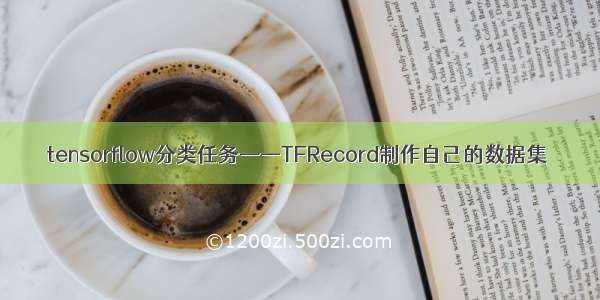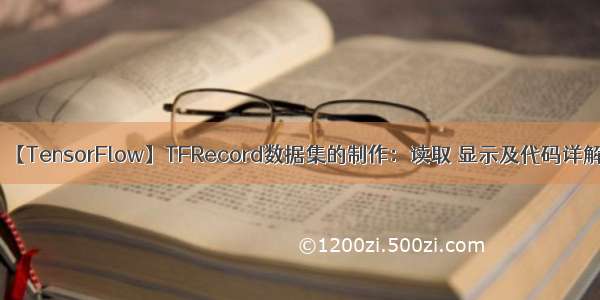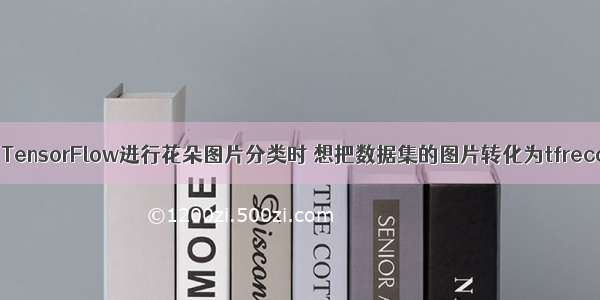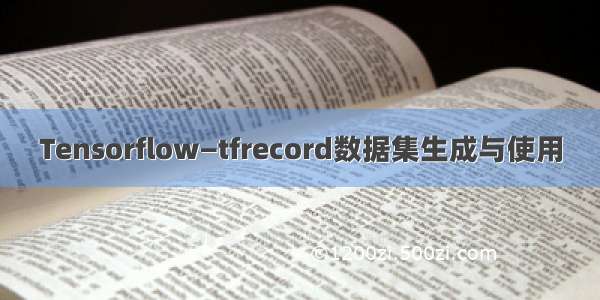
制作数据集的前菜——打乱数组
x, y = imageNumpyData()state = np.random.get_state()np.random.shuffle(x)np.random.set_state(state)np.random.shuffle(y)# 打乱之后的x,y作为训练数据x = np.array(x)y = np.array(y)
代码运行之前,x是一个list,y是一个array使用随机数的方式打乱数据如果x和y的数据样本数不一样,容易出现错误打乱之后全部变成array
制作数据集的正餐
数据集的流程:
先读取输入,并把数据保存成固定通道,固定维数。保存成numpy的形式,之后打乱数据集数据集一张一张写入TFRecord中注意事项:
Data里面存放数据record里面存放制作成功的数据集需要提前准备好了record这个文件夹,不然容易报错,如果要自动创建文件夹请看我另一篇博客,这个不做赘述我的图片格式是JPEG,我在代码中写了判断,同时也可以制作BMP和PNG类型的图片我的图片是灰度图,所以是单通道,读者若是彩色图片,相应更改代码,我在下面的解释中有说明所有代码
import numpy as npimport tensorflow as tfimport osfrom PIL import Imageimport base64import matplotlib.pyplot as pltdef imageNumpyData():# the classification file root pathrootFilePath = './Data/'rootAbsPath = os.path.abspath(rootFilePath)node1FloderPath = os.listdir(rootAbsPath)node1Path = [os.path.join(rootAbsPath, nodePath) for nodePath in node1FloderPath]label = 0imageLabel = []imageData = []for imagePath in node1Path:display = 0image = os.listdir(imagePath)image = [os.path.join(imagePath, file) for file in image]# 使用tensorflowwith tf.Session() as sess:for image_raw in image:try:img = Image.open(image_raw)if img.format == "BMP":image_raw_data = tf.gfile.FastGFile(image_raw, 'rb').read()image_data = tf.image.decode_bmp(image_raw_data)if img.format == "JPEG":image_raw_data = tf.gfile.FastGFile(image_raw, 'rb').read()image_data = tf.image.decode_jpeg(image_raw_data)if img.format == "PNG":image_raw_data = tf.gfile.FastGFile(image_raw, 'rb').read()image_data = tf.image.decode_png(image_raw_data)if image_data.dtype != tf.float32:image_data = tf.image.convert_image_dtype(image_data, dtype=tf.float32)image_data = tf.image.resize_images(image_data, [224, 224])image_temp = np.array(sess.run(image_data))if image_temp.shape[2] == 1:imageData.append(image_temp)imageLabel.append(label)display = display + 1print(str(label) + ':' + str(display))except:print(image_raw + '读取失败')# os.remove(image_raw)label = label + 1one_hot = tf.one_hot(imageLabel, label)with tf.Session() as sess:sess.run(tf.global_variables_initializer())imageLabel = sess.run(one_hot)return imageData, imageLabeldef tfRecordWrite(filename):# 生成整数的属性def _int64_feature(value):return tf.train.Feature(int64_list=tf.train.Int64List(value=[value]))# 生成字符串型的属性def _bytes_feature(value):return tf.train.Feature(bytes_list=tf.train.BytesList(value=[value]))# filename = 'record/Imageoutput.tfrecords'writer = tf.python_io.TFRecordWriter(filename)x, y = imageNumpyData()state = np.random.get_state()np.random.shuffle(x)np.random.set_state(state)np.random.shuffle(y)# 打乱之后的x,y作为训练数据x = np.array(x)y = np.array(y)# 将每张图片都转为一个Exampleheight = x.shape[1]width = x.shape[2]channels = x.shape[3]n_class = y.shape[1]x = x.reshape([-1, height, width, channels])division = int(x.shape[0] * 0.9)x_train = x[:division]y_train = y[:division]x_test = x[division:]y_test = y[division:]np.savez('testData.npz', test_X=x_test, test_Y=y_test, height=height, width=width, channels=channels,n_class=n_class)del x_test, y_testfor i in range(x_train.shape[0]):image = x_train[i].tostring() # 将图像转为字符串example = tf.train.Example(features=tf.train.Features(feature={'image': _bytes_feature(image),'label': _int64_feature(np.argmax(y_train[i]))}))writer.write(example.SerializeToString()) # 将Example写入TFRecord文件writer.close()return height, width, channels, n_classfilename = r'./record\Imageoutput.tfrecords'height, width, channels, n_class = tfRecordWrite(filename)print(height, width, channels, n_class)print('data processing success')
关键代码解释
try:img = Image.open(image_raw)if img.format == "BMP":image_raw_data = tf.gfile.FastGFile(image_raw, 'rb').read()image_data = tf.image.decode_bmp(image_raw_data)if img.format == "JPEG":image_raw_data = tf.gfile.FastGFile(image_raw, 'rb').read()image_data = tf.image.decode_jpeg(image_raw_data)if img.format == "PNG":image_raw_data = tf.gfile.FastGFile(image_raw, 'rb').read()image_data = tf.image.decode_png(image_raw_data)
解释:尝试打开图片,并且图片格式是JPEG,BMP或PNG, tf.gfile.FastGFile的这个地方必须要‘rb’,我看一些书上仅仅是写了一个‘r’,这样并不对。
if image_data.dtype != tf.float32:image_data = tf.image.convert_image_dtype(image_data, dtype=tf.float32)
解释:我做CNN的中,需要float32,这里必须转格式
image_data = tf.image.resize_images(image_data, [224, 224])
解释:把图片更改大小
if image_temp.shape[2] == 1:imageData.append(image_temp)imageLabel.append(label)
解释:我的是灰度图,所以这里**‘’==1‘’,若是三通道,则‘==3’**
one_hot = tf.one_hot(imageLabel, label)with tf.Session() as sess:sess.run(tf.global_variables_initializer())imageLabel = sess.run(one_hot)
解释:把得到的label,转换成one-hot形式
x = x.reshape([-1, height, width, channels])division = int(x.shape[0] * 0.9)x_train = x[:division]y_train = y[:division]x_test = x[division:]y_test = y[division:]np.savez('testData.npz', test_X=x_test, test_Y=y_test, height=height, width=width, channels=channels,n_class=n_class)del x_test, y_test
解释:这里是我拿出一部分数据保存成‘npz’的形式作为我的测试集,因为我用tfrecord格式的数据作为训练集
# 生成整数的属性def _int64_feature(value):return tf.train.Feature(int64_list=tf.train.Int64List(value=[value]))# 生成字符串型的属性def _bytes_feature(value):return tf.train.Feature(bytes_list=tf.train.BytesList(value=[value]))
解释:这是我们必须遵从的规则,用整数属性写入label,用字符串形式写入图像数据
# filename = 'record/Imageoutput.tfrecords'writer = tf.python_io.TFRecordWriter(filename)
解释:开始写入,并生成文件
for i in range(x_train.shape[0]):image = x_train[i].tostring() # 将图像转为字符串example = tf.train.Example(features=tf.train.Features(feature={'image': _bytes_feature(image),'label': _int64_feature(np.argmax(y_train[i]))}))writer.write(example.SerializeToString()) # 将Example写入TFRecord文件writer.close()
解释:根据数据集大小,一个一个的写入
数据集地址:
链接:/s/1aIHzKsxUb67sJZAFrGH1ZQ
提取码:lvjp
工程地址:
链接:/s/1XGAA6UQ0JByhvDYQ__my4g
提取码:dxpn
结束语
希望大家积极学习,有不懂的地方可以加我的微信:ChaofeiLi














